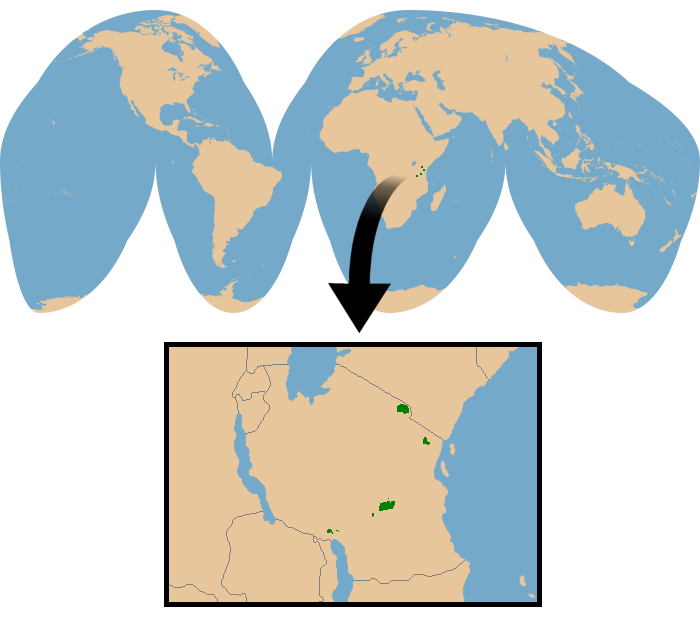Kingdom: |
Animalia Chordata Mammalia Artiodactyla Ruminantia Bovidae Cephalophinae Cephalophus |
Common name:
Scientific name:
Other names: |
Abbott's duiker
Cephalophus spadix
Céphalophe d'Abbott, Abbottducker, Mende, Minde, Vinde or Muvinde, Binde |
Physical Characteristics
- Head and body length:
100-140 cm
- Shoulder height: 65-75 cm
- Tail length: 8-13 cm
- Adult weight: 50-60 kg
- Shoulder height: 65-75 cm
Abbott's duiker is a large-bodied duiker with short legs and a thick neck. The coat, which is short and glossy, is an overall very dark brown or black in color. The undersides are pale brown (usually with a reddish tone), and the throat and face are pale grayish-brown. There are no conspicuous facial markings, but the upper lip is whitish and the forehead deep brown in color. A distinctive bushy crest of long hair grows at the top of the head between the ears; this may vary in color from pale brown to deep chestnut, but it usually has a bright reddish hue. Sharp spike-like horns are present in both sexes, and are directed backwards from the top of the head in line with the forehead. Although the horns are long (8-12 cm) compared to most other duikers, they are sometimes entirely hidden by the thick forehead tuft.
- Similar species
- The yellow-backed duiker (Cephalophus silvicultor) is similar in size and coloration, but has a distinctive yellow wedge from mid-back to rump and has a much shorter and sparser forehead crest.
- Ignoring the substantial difference in size, Abbott's duiker and the black duiker (Cephalophus niger) are remarkably similar in appearance, both being dark with reddish crests. They are easily distinguished on the basis of their native ranges (west Africa versus Tanzania).
Reproduction and Development
Ecology and Behavior
- Family group:
Solitary.
- Diet: Principally fruit, but also leaves, flowers, and animal matter.
- Main Predators: Leopard, lion, spotted hyena. African crowned eagle and pythons may hunt youngsters.
- Diet: Principally fruit, but also leaves, flowers, and animal matter.
Habitat and Distribution

Conservation Status
- IUCN Red List:
Endangered (2008).
- CITES Listing: Not listed (2012).
- Threats: Snaring, habitat loss (to agriculture and logging).
- CITES Listing: Not listed (2012).
Abbott's duiker is a difficult species to survey on account of its shyness and nocturnal nature. There are an estimated 1,500 individuals remaining in the wild. However, populations are extremely fragmented, and only two viable populations may remain (in the Udzingwa Mountains and on Mount Kilimanjaro).


